-


Staffordshire, England
Earthenware, transfer-printed
Marked ‘Copeland, late Spode’
A beautiful earthenware dish Arabic inscriptions made for the Islamic markets. The inscription in the Center translates as ‘Allah the one, there is no partner to Him/ Muhammad is the Prophet of Allah/ Indeed you are the Conqueror.’ The top and bottom inscriptions on the outer border translate as ‘There is no God but Allah.’ The names of the four Caliphs, Abubaker, Umar, Usman and Ali also appear on the outer border in vignettes among foliate swirls.
Manufacturers and retailers in Britain, looking to expand their markets to the British empire and beyond, started production of plates with inscriptions in Arabic taken from the Qur’an. These plates sometimes found in Indonesia and India were made for sale in countries with a significant Muslim population. An identical Copeland plate, but in blue is in the collection of the V&A, London.
Size (cms): 5.75(H) x 29.25(Diam)
Size (inches): 2.5(H) x 11.5(Diam)
-
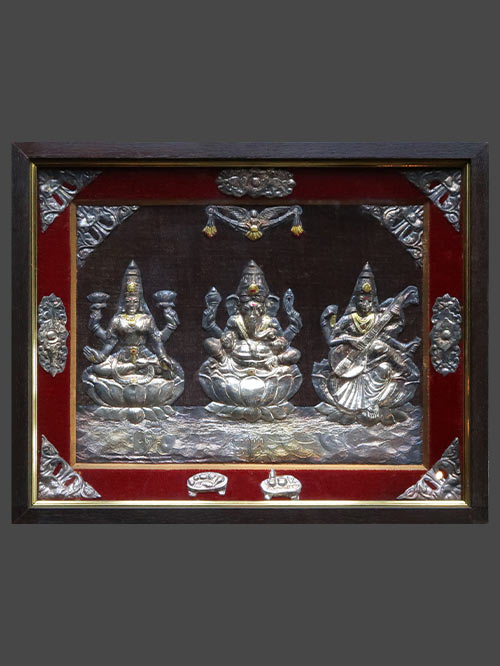
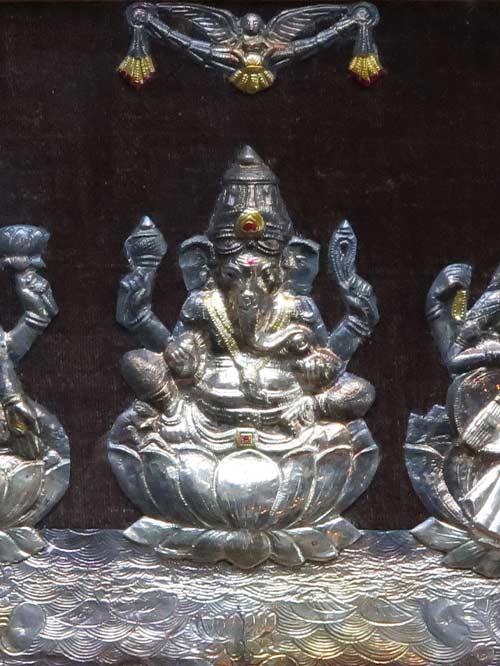
Tamil Nadu (South India)
silver repoussé on velvet
Ganesha, four armed, is seated cross legged on a lotus throne. He carries a mace, a noose, a ball of modak and his broken tusks in his four hands. Directly above is the figure of a single winged angel with stylised wings. He is flanked by the figures of Lakshmi and Saraswati, each seated on their lotus thrones. The deities appear to float on the waves of the cosmic ocean.
Framed Size (cms): 42 (H) x 54 (W)
Framed Size (inches): 16.5 (H) x 21 (W)
-
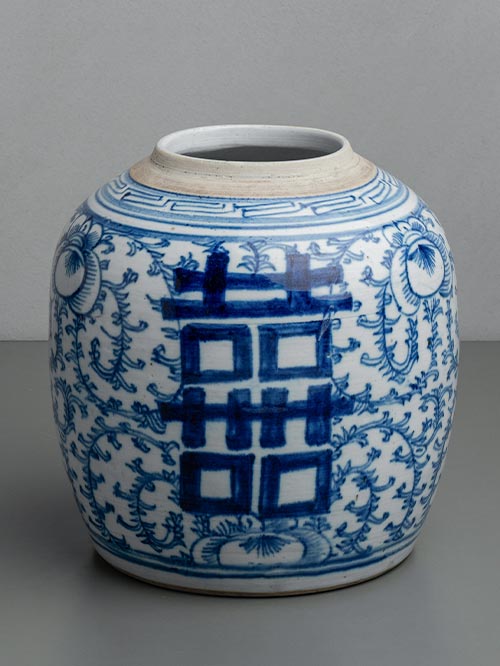

China (for the export market)
Porcelain, ‘floral patterns and characters’
Ginger jars are steeped in centuries of Chinese culture and history. Shaped with a wide mouth, a domed lid and a bulging, bulbous spherical hand painted body, they come in various styles and sizes and many different colours. Porcelain Chinese ginger jars were originally used to store food supplies like salt, herbs, oil and ginger (rare spices at that time), other ginger jars were allocated to be used as gifts. The jars acquired the name “ginger jars” because they often contained ginger when they were exported to the West. Some of the decorative treatments on ginger jars have included dragons, carp, landscapes, and florals, either glazed in a rainbow of colours or limited to the blues and whites of flow blue. Because of their wide shape, ginger jars lent themselves to a “rose medallion” treatment, in which florid designs around the jar framed smaller scenes, almost like a graphic novel in porcelain.
Size (cms): 22.5(H) x 22(Diam)
Size (inches): 9(H) x 8.5(Diam)
-
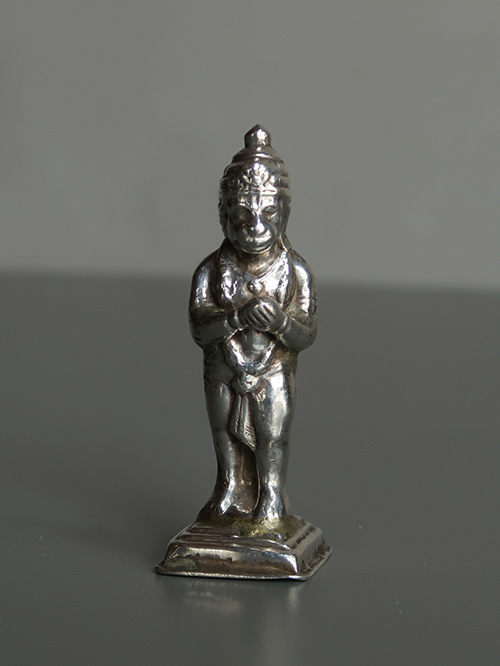

Maharashtra
silver
A charming yet worn figure of Hanuman standing with his hands held together. His tail extends from the right hip upward terminating above his head.
The story of Hanuman is found in the Ramayana where he is the ubiquitous servant, the epitome of devoted service and loyalty. His search for the heroine Sita, captured by Ravana, illustrates his superhuman powers and zealous performance of the tasks that were given to him.
Size (cms): 8.8(H) x 3.1(W) x 4.6(D)
Size (inches): 3.5(H) x 1(W) x 2(D)
-
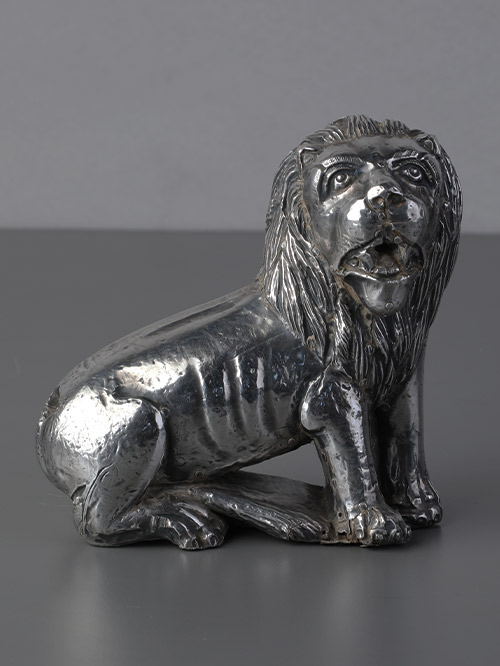

Gujarat
silver on wood
A decorative silver lion with a wooden frame. The ferocious looking lion is seated on its hind legs and is open mouthed, exposing large teeth. These would have served as symbolic supports to the inner sanctum of home shrine.
Among the Jains the lion served as the mount of Mahavira, the 24th and last Jina. Mahavira was the twenty-fourth Tirthankara (ford-maker) of Jainism which was revived and reestablished by him. In the Jain tradition, it is believed that Mahavira was born in the early part of the 6th century BC into a royal family in what is now Bihar, India. At the age of thirty, abandoning all worldly possessions, he left his home in pursuit of spiritual awakening and became an ascetic. For the next twelve and a half years, Mahavira practiced intense meditation and severe austerities, after which he is believed to have attained omniscience.
Size (cms): 15(H) x 14.5(W) x 7.5(D)
Size (inches): 6(H) x 5.5(W) x 3(D)
-


Tamil Nadu
polychromed terracotta
An attractive pair of Lion vahanas with lovely patina and extensive polychroming. They are depicted mid-stride walking within tall foliage. Terracotta toys were used as ritual display in temples during important festivals such as Holi, Shivaratri and Durga Puja.
The Lion is the vehicle of, and sacred to the Hindu goddess, Durga. From a certain perspective she is India’s Mother Nature, for she is the deification of Energy. Her consort, Shiva, sometimes evoked as Shambo, wears a tiger skin to indicate that he is beyond the bounds of the natural world.
Individual Sizes (cms): 18(H) x 25(W) x 10.5(D)
Individual Sizes (inches): 7(H) x 10(W) x 4(D)
-


Rajasthan
silver
Fine silver circular tray with a domed perfume container. The outer border of the tray is tray decorated with chased floral and geometric designs enclosing a double band of petal like cusped lobes reminiscent of architectural niches. The central perfume container sits within a chased floral band and has a hinged onion shaped domed lid with stepped patterns and a knop finial. Perfumes in Mughal India were used not just to scent oneself but also for medicinal purposes, the most common type of perfume was attar of roses.
Size (cms): 7(H) x 18.5(Diam)
Size (inches): 3(H) x 7.5(Diam)
-

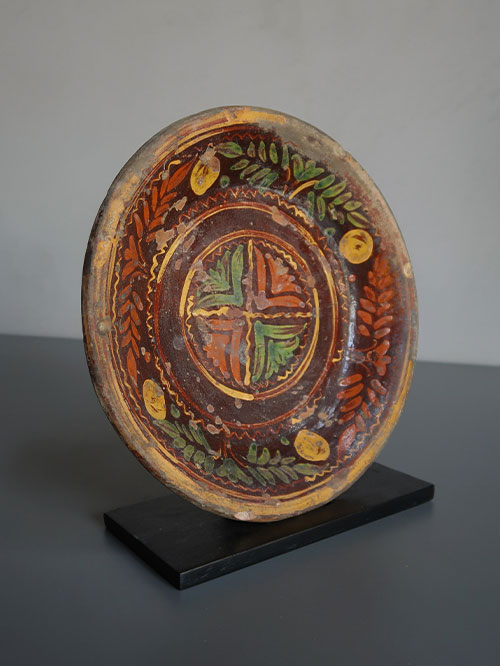
Sindh
glazed pottery
A decorative glazed pottery dish from the Sindh region, beautiful for its simplicity in shape, the spontaneity, directness, and propriety of its ornamentation, and the beauty of its colouring. This dish is very different from the commonly available unglazed pottery of Sindh and the Punjab. The glazed pottery of Sindh is made principally at Hala, Hyderabad, Tatta and Jerruck. The pieces are glazed mostly in turquoise, of the most perfect transparency, or in a rich dark purple, or dark green, or golden brown. Sometimes they are diapered all over by the pâte-sur-pâte method, with a conventional flower, the seventi, or lotus, of a lighter colour than the ground. Generally they are ornamented with the universal knop and flower pattern, in compartments formed all round the bowl, by spaces alternately left uncoloured and glazed in colour. Sometimes a wreath of the knop and flower pattern is simply painted round the bowl on a white ground. The glazed pottery of Sindh also inspired the Bombay School of Art pottery. Some of the best potters from Sindh were brought to the School to teach the pupils the technique.
Size (cms): 3.75(H) x 26(Diam)
Size (inches): 1.5(H) x 10(Diam)
-

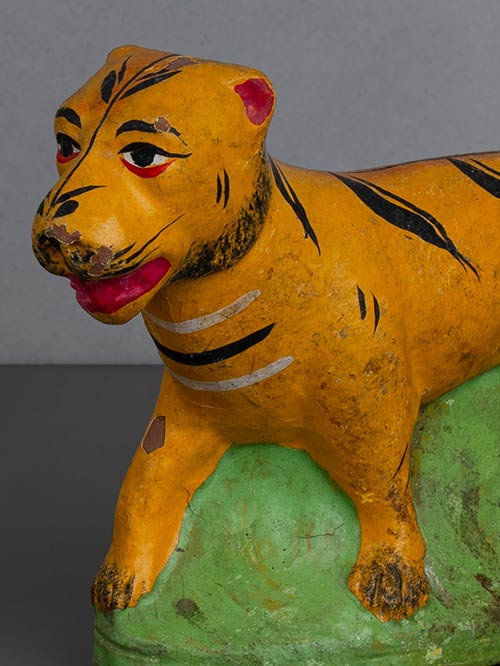
Tamil Nadu
polychromed terracotta
A charming Tiger Vahana with lovely patina and extensive polychroming. The tiger is depicted mid-stride walking within tall foliage. Terracotta toys were used as ritual display in temples during important festivals such as Holi, Shivaratri and Durga Puja.
The tiger is the vehicle of, and sacred to, the Hindu goddess, Durga. From a certain perspective she is India’s Mother Nature, for she is the deification of Energy. Her consort, Shiva, sometimes evoked as Shambo, wears a tiger skin to indicate that he is beyond the bounds of the natural world.
Size (cms): 12(H) x 16(W) x 6.5(D)
Size (inches): 4.5(H) x 6.5(W) x 2.5(D)
-
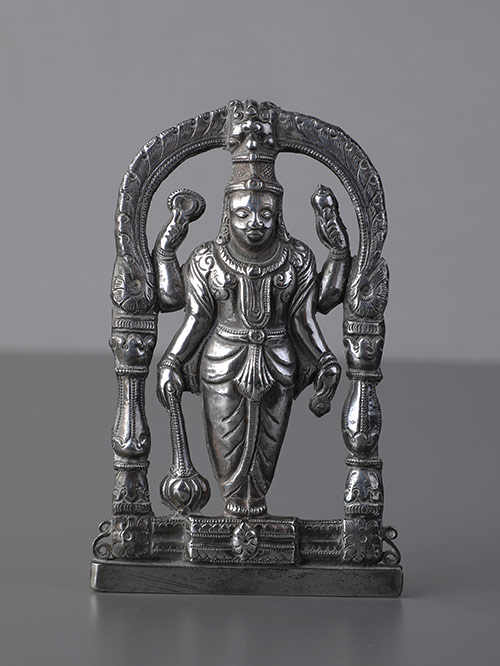
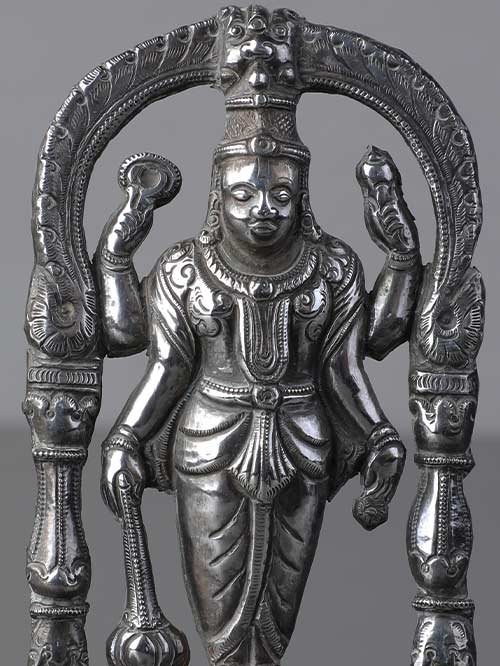
Maharashtra
silver
A finely cast and decorated standing figure of Vishnu. Four-armed, the figure carries a gada (mace), chakra (disc) conch and lotus. He wears multiple ear and neck ornaments and a tall crown surmounted by a Kirtimukha which forms a ritual arch around the figure. Vishnu means ‘All Pervader’, or taking many forms’ is one of the most important Hindu deities along with Shiva and Brahma. He is the sustainer of the universe and sometimes descends to earth assuming various forms (avatars) to redress the balance between good and evil, and hence is known as the Preserver.
Size (cms): 13.5(H) x 8.5(W) x 5(D)
Size (inches): 5.5(H) x 3.5(W) x 2(D)
-
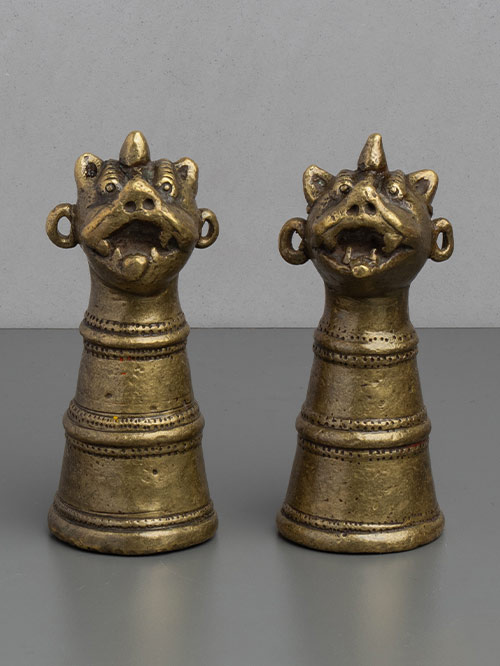

Karnataka
Brass
A decorative pair of horn cap ornaments with vyali (lion) finials. They would have been fixed to nandi (bull) horn ends as a decorations for the Pola festival, during which draft animals are thanked for their help in plowing the fields.
Nandi or nandin, the bull vahana of Shiva has always been noted for his strength and virility. Usually depicted in a life-like naturalistic manner, Nandi is present in every Shaivite temple, often with his own temple enclosure but facing the Shiva lingam. Figures like this of Nandi on a platform base with a cobra canopy are common objects of worship, especially found in home shrines.
Indiv. Sizes (cms): 12(H) x 5(W) x 5(D) each
Indiv. Sizes (inches): 4.5(H) x 2(W) x 2(D) each
-


Karnataka (South India)
brass alloy
This gracefully proportioned standing Nandi is delicately incised with head and neck ornaments and stands on a trapezoidal base.
Nandi or nandin, the bull vahana of Shiva has always been noted for his strength and virility. Usually depicted in a life-like naturalistic manner, Nandi is present in every Shaivite temple, often with his own temple enclosure but facing the Shiva lingam. Figures like this of Nandi on a platform base with a cobra canopy are common objects of worship, especially found in home shrines.
Size (cms): 16.5(H) x 10.8(W) x 7.6(D)
Size (inches): 6.5(H) x 4.5(W) x 3(D)
-
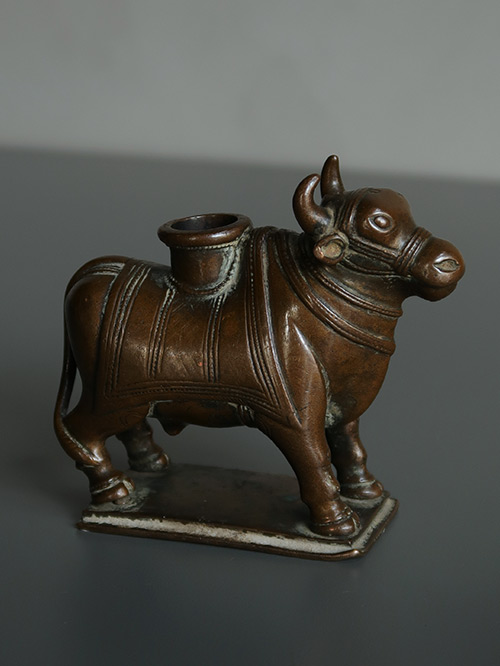

Karnataka (South India)
copper alloy
A beautifully caparisoned copper Nandi standing on a rectangular plinth. The Nandi wears an engraved saddle blanket which is surmounted by a bowl-like structure which would have held an incense burner or an oil reservoir. He is bridled and decorated with necklaces around his neck.
Nandi or nandin means rejoicing, gladdening. It is the name of Shiva’s conveyance (vahana) the white bull. Nandi was probably a folk deity later incorporated into the Brahmanic lore. Nandi symbolises on the one hand moral and religious duty (dharma), and on the other, virility, fertility and strength. Apart from being Shiva’s vehicle, nandi in his form as nandikeshvara, depicted as a human with a bulls head, is believed to be one of the great masters of music and dancing. In southern India his recumbent image is placed either opposite the main sanctuary or in the hall leading to it, facing the linga.
Size (cms): 10.8(H) x 11.5(W) x 4.7(D)
Size (inches): 4.5(H) x 4.5(W) x 2(D)
-
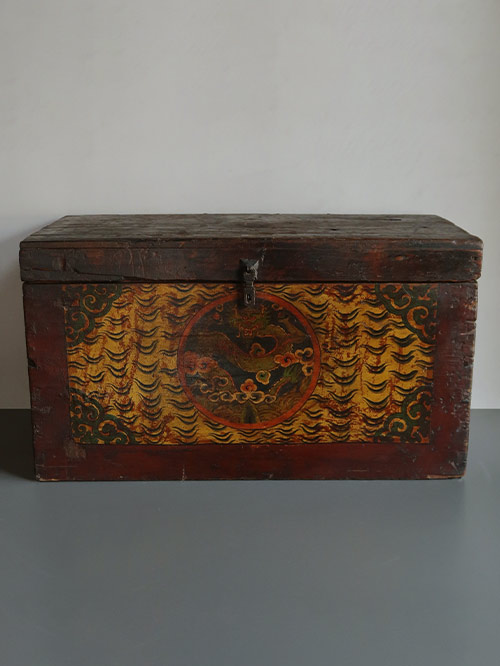
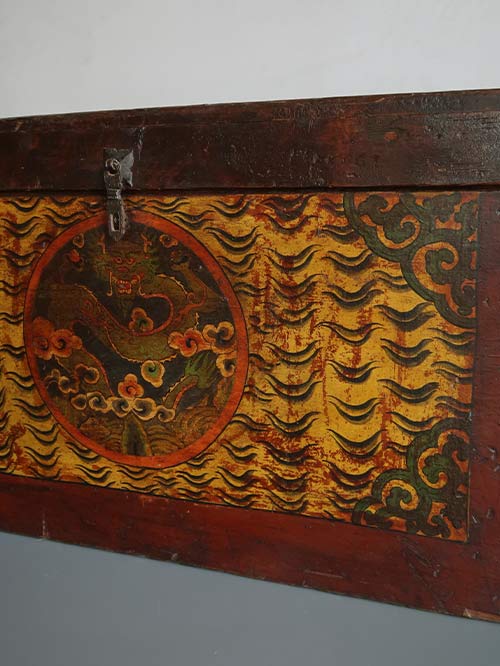
Tibet
Wood, with original polychroming
The chest is decorated in vibrant polychrome pigments with a central roundel enclosing a ferocious writhing dragon grasping a flaming pearl amongst cloud scrolls. The roundel is centred on top of a geometric tiger pattern which is set within cusped corner spandrels.
Tibetan chests and trunks were used as storage in homes and monasteries. Boxes are normally made from cedar, pine, or poplar. If they are painted it is usually just the front and two sides. They can either be painted directly on the wood or on some pieces onto a fabric applied to the wood. The colours and designs used are very decorative. It’s painted with paints mixed from minerals, as was the way during this period, and it will therefore always retain its vibrancy. The sides are decorated with stylised foliate panels.
Size (cms): 47(H) x 88(W) x 48.5(D)
Size (inches): 18.5(H) x 34.5(W) x 19(D)
-
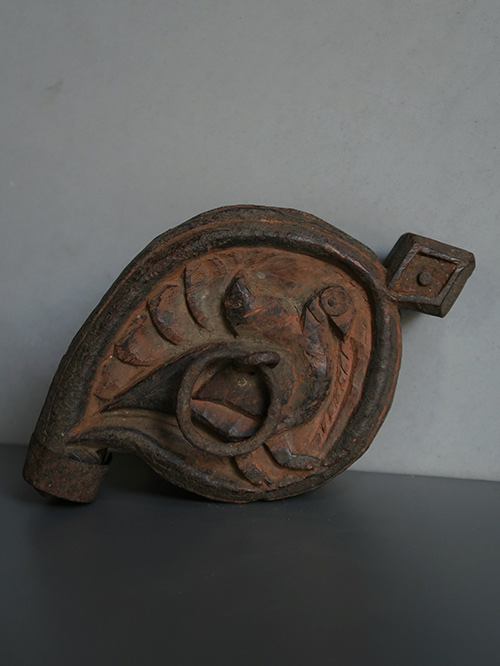
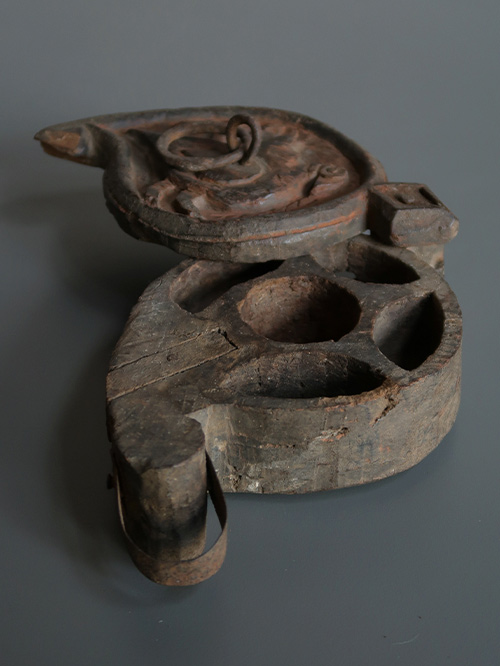
Karnataka (South India)
Wood, polychromed
An unusual vermillion box with a stylised Hamsa (goose) on the lid, and five containers inside.
The hamsa a mythological aquatic bird that resembles a goose or a swan. The hamsa is one of the most important of the Indian birds and is a familiar motif in Indian art, literature, sculpture and textiles. Revered by Hindus, Buddhists and Jains, it plays a prominent role in mythology, folklore, literature and religion. In Vedic times the hamsa was connected with the sun and represented virility. It is reputed to eat pearls and to be able to separate milk from water. The hamsa is the vahana of Brahma.
Sindoor is a traditional vermilion red or orange-red colored cosmetic powder from India, usually worn by married women along the part of their hair. In Hindu communities the use of sindoor indicates a woman is married and ceasing to wear it usually implies widowhood. Sindoor originally comes from the sindoor tree and is used mainly for religious purposes, when worshiping the deity and other Hindu rituals. The main component of modern traditional sindooram is usually turmeric.
Size (cms): 8(H) x 20(W) x 12(D)
Size (inches): 3(H) x 8(W) x 4.5(D)
-
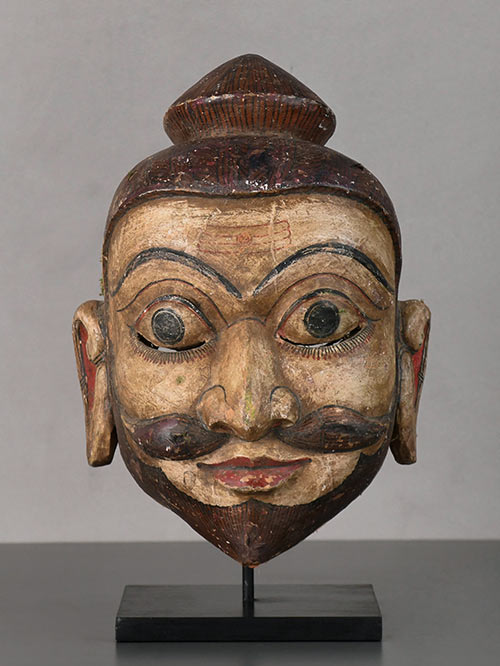

Orissa
Wood, polychromed
This striking festival mask unusually depicts an ascetic. The moustached and bearded ascetic wears a characteristic topknot. Exquisitely carved, the Ascetic has a serene expression with almond-shaped eyes below elegantly arched eyebrows, and his full lips form a subtle smile. A prominent Shaivite Tripundra marks his forehead. Tiny ovular slits have been cut out beneath the eyes to assist the dancer in navigating while wearing the mask.
Shahi Jatras (royal processions) of Orissa present different episodes from the Ramayana during the spring season, usually lasting for for one week. Actors, carrying huge wooden masks and gorgeous costumes, walk on the streets with stylised gait and mime with the accompaniment of loud drumming. The Desia Nata of Koraput, Orissa, also uses masks for representing gods, goddesses, animals, birds and demons. These themes are also taken from Ramayana.
Mask Size (cms): 48(H) x 33(W) x 20(D), 51(H with Stand)
Mask Size (inches): 19(H) x 13(W) x 8(D), 20(H with Stand)

































